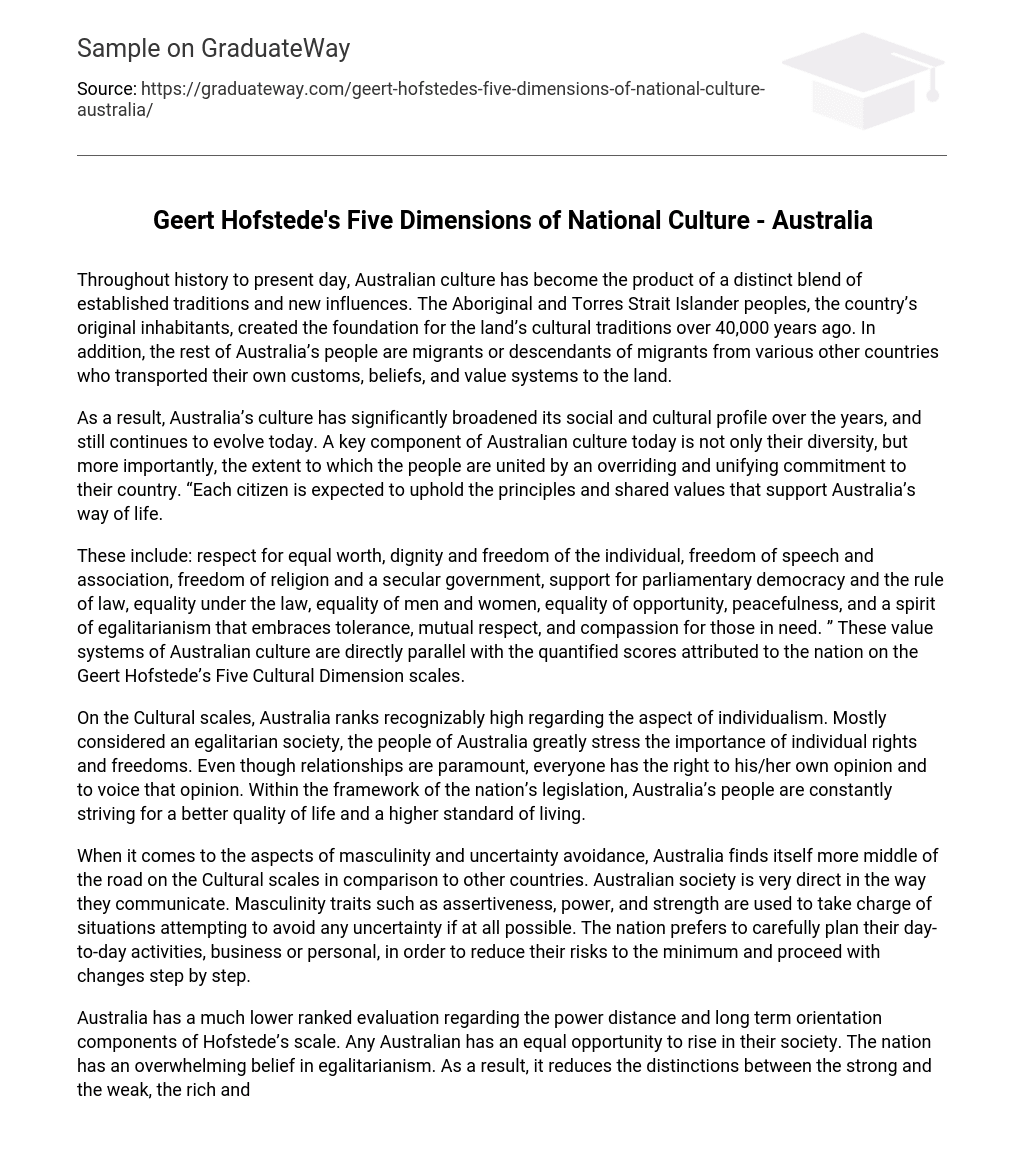The culture of Australia has evolved over time, combining ancient traditions with contemporary influences. The Indigenous peoples, who have inhabited the country for countless years, laid the groundwork of its cultural heritage. Additionally, Australia accommodates a varied population of immigrants and their offspring from different nations, each bringing forth their unique customs, beliefs, and values.
Australia’s social and cultural profile has experienced substantial growth, constantly evolving. A key element of Australian culture is the unity among its people through their dedication to their country. Every citizen is expected to uphold the principles and shared values that shape Australia’s way of life.
These value systems of Australian culture are directly parallel with the quantified scores attributed to the nation on the Geert Hofstede’s Five Cultural Dimension scales. These values include: respect for equal worth, dignity and freedom of the individual, freedom of speech and association, freedom of religion and a secular government, support for parliamentary democracy and the rule of law, equality under the law, equality of men and women, equality of opportunity, peacefulness, and a spirit of egalitarianism that embraces tolerance, mutual respect, and compassion for those in need.
Australia is renowned for its high rating in individualism on the Cultural scales. It is predominantly acknowledged as an egalitarian society that prioritizes individual rights and freedoms. While relationships hold significance, every person has the entitlement to their own viewpoints and the liberty to articulate them. The citizens of Australia consistently endeavor towards an improved quality of life and a superior standard of living within the country’s legislative structure.
Australia is positioned in the middle in terms of masculinity and uncertainty avoidance on the Cultural scales compared to other countries. In Australian society, communication is very direct, with an emphasis on assertiveness, power, and strength in order to control situations and minimize uncertainty. Australians prefer to plan their daily activities, whether personal or business-related, in a careful manner to minimize risks and implement changes gradually.
When compared to Hofstede’s scale, Australia shows a lower rank in power distance and long-term orientation. In Australian society, there is a belief in egalitarianism, providing equal opportunities for advancement and reducing social and organizational distinctions between different groups. The country also emphasizes tradition, authenticity, sincerity, modesty, and personal stability, which supports their low power distance and short-term orientation.
The United States can be compared to Australia in terms of rankings across each dimension. This highlights the high importance and similarity between both cultures. By comparing values and traditions within each culture, we can better understand why they have comparable rankings in each dimension. Both countries hold the highest global ranking for individualism; valuing individual liberties, self-sufficiency, and equality.
While valuing family, both Australia and the United States highly value individual achievements. This emphasis is also reflected in their political and economic systems, where pursuing personal interests leads to overall economic success and benefits for society. Additionally, both countries have a Power Distance Index ranking below the global average of 55, indicating relatively fair social hierarchies and equal opportunities for individuals to succeed.
The ranking represents individuals who can communicate ideas and opinions to those in positions of power. The different levels are open to communication and encourage cooperation. The global average for the Masculinity Dimension is 50, but both the United States and Australia have a higher ranking. Traits associated with masculinity include assertiveness, material success, and individual achievement. The female population has adopted these traits and started moving towards traditional male roles, with more women joining the workforce.
The direct communication style of the United States exemplifies masculine traits, prioritizing conveying their message over building relationships. This trait is closely tied to both countries’ individuality rankings. Both the United States and Australia rank below the global average of 45 in terms of long-term orientation. The significance placed on fulfilling immediate commitments and honoring traditions is reflected in their short-term orientation.
Australia’s culture is the reason for its ranking, while personal stability and “protecting face” are emphasized in the United States. The global average for Uncertainty Avoidance is 64, and both Australia and the United States rank below this average. Both countries are in the middle range, with Australia slightly higher than the United States. Although there is structure and a tendency to plan certain activities, the United States does not try to control all activities and economic outcomes.
There are general guidelines and rules that promote individual freedoms and a more open market system. This enables the emergence of fresh ideas and diverse perspectives within a group and society. Australia and the United States exhibit comparable rankings on Geert Hofstede’s five cultural dimensions. They share commonalities and prioritize similar aspects in their national culture, such as individual rights and tradition. The aforementioned information underscores the significant qualities that shape each nation’s culture and elucidate their respective rankings.





